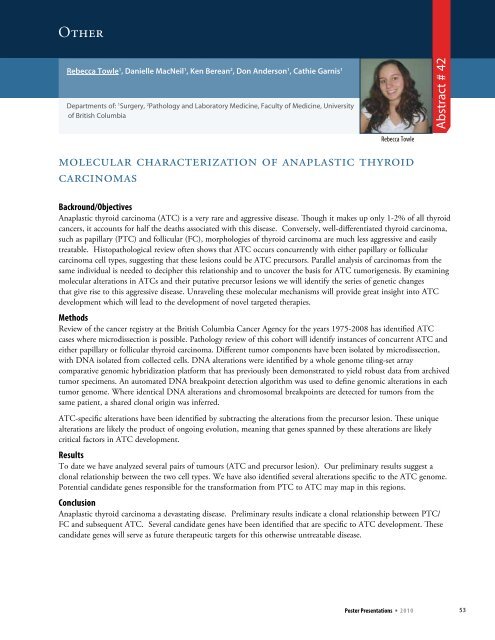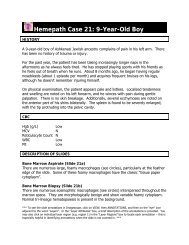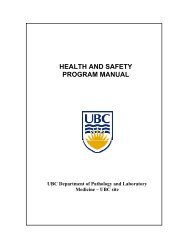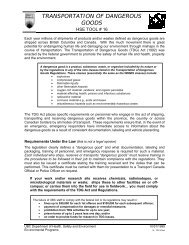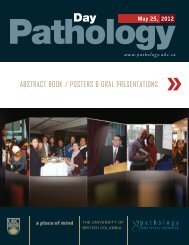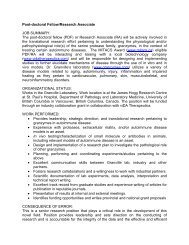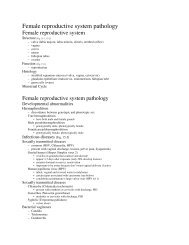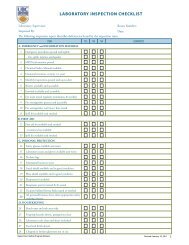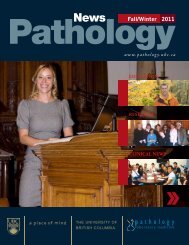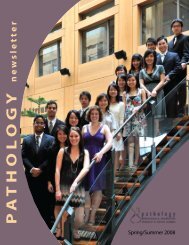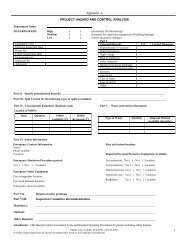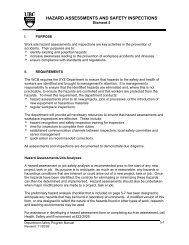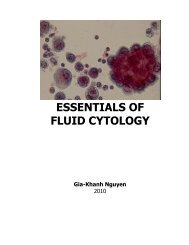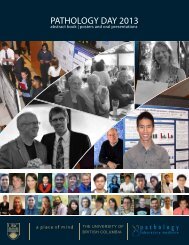Oral Presentations - Pathology and Laboratory Medicine - University ...
Oral Presentations - Pathology and Laboratory Medicine - University ...
Oral Presentations - Pathology and Laboratory Medicine - University ...
You also want an ePaper? Increase the reach of your titles
YUMPU automatically turns print PDFs into web optimized ePapers that Google loves.
OtherRebecca Towle 1 , Danielle MacNeil 1 , Ken Berean 2 , Don Anderson 1 , Cathie Garnis 1Departments of: 1 Surgery, 2 <strong>Pathology</strong> <strong>and</strong> <strong>Laboratory</strong> <strong>Medicine</strong>, Faculty of <strong>Medicine</strong>, <strong>University</strong>of British ColumbiaAbstract # 42Rebecca Towlemolecular characterization of anaplastic thyroidcarcinomasBackround/ObjectivesAnaplastic thyroid carcinoma (ATC) is a very rare <strong>and</strong> aggressive disease. Though it makes up only 1-2% of all thyroidcancers, it accounts for half the deaths associated with this disease. Conversely, well-differentiated thyroid carcinoma,such as papillary (PTC) <strong>and</strong> follicular (FC), morphologies of thyroid carcinoma are much less aggressive <strong>and</strong> easilytreatable. Histopathological review often shows that ATC occurs concurrently with either papillary or follicularcarcinoma cell types, suggesting that these lesions could be ATC precursors. Parallel analysis of carcinomas from thesame individual is needed to decipher this relationship <strong>and</strong> to uncover the basis for ATC tumorigenesis. By examiningmolecular alterations in ATCs <strong>and</strong> their putative precursor lesions we will identify the series of genetic changesthat give rise to this aggressive disease. Unraveling these molecular mechanisms will provide great insight into ATCdevelopment which will lead to the development of novel targeted therapies.MethodsReview of the cancer registry at the British Columbia Cancer Agency for the years 1975-2008 has identified ATCcases where microdissection is possible. <strong>Pathology</strong> review of this cohort will identify instances of concurrent ATC <strong>and</strong>either papillary or follicular thyroid carcinoma. Different tumor components have been isolated by microdissection,with DNA isolated from collected cells. DNA alterations were identified by a whole genome tiling-set arraycomparative genomic hybridization platform that has previously been demonstrated to yield robust data from archivedtumor specimens. An automated DNA breakpoint detection algorithm was used to define genomic alterations in eachtumor genome. Where identical DNA alterations <strong>and</strong> chromosomal breakpoints are detected for tumors from thesame patient, a shared clonal origin was inferred.ATC-specific alterations have been identified by subtracting the alterations from the precursor lesion. These uniquealterations are likely the product of ongoing evolution, meaning that genes spanned by these alterations are likelycritical factors in ATC development.ResultsTo date we have analyzed several pairs of tumours (ATC <strong>and</strong> precursor lesion). Our preliminary results suggest aclonal relationship between the two cell types. We have also identified several alterations specific to the ATC genome.Potential c<strong>and</strong>idate genes responsible for the transformation from PTC to ATC may map in this regions.ConclusionAnaplastic thyroid carcinoma a devastating disease. Preliminary results indicate a clonal relationship between PTC/FC <strong>and</strong> subsequent ATC. Several c<strong>and</strong>idate genes have been identified that are specific to ATC development. Thesec<strong>and</strong>idate genes will serve as future therapeutic targets for this otherwise untreatable disease.Poster <strong>Presentations</strong> * 2 0 1 053


